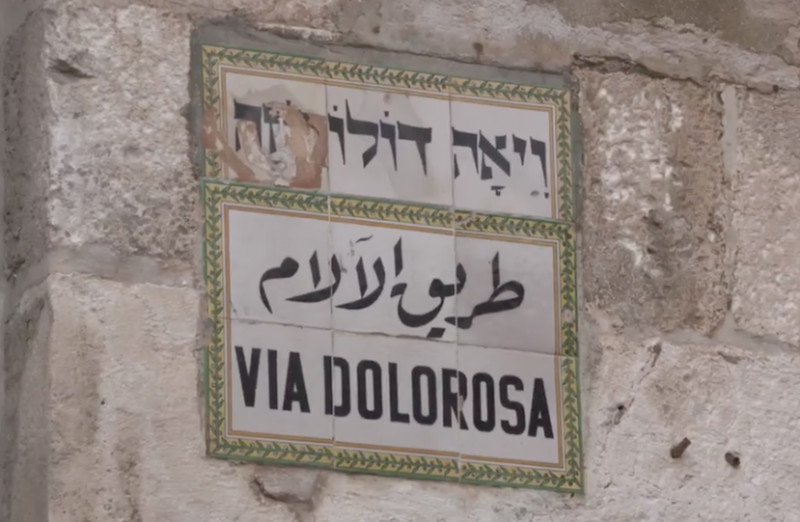
GIL ZOHAR, writing for Religion Unplugged, reports from Israel…
Jerusalem, Israel
Via Religion Unplugged
Franciscans in the Holy Land, a Catholic order that’s preserved Christian sites in Jerusalem since the Middle Ages, have celebrated Lent for years by following the path, step-by-step, that Jesus may have taken nearly 2,000 years ago on his 40-day fasting journey through the Judean Desert.
This year, worshippers around the world can join the pilgrimage virtually, walking along the Via Dolorosa (the Way of Sorrows) in the Old City of Jerusalem and even dragging a cross to Golgotha, where Jesus was crucified.
The internet broadcast, which has been seen every Tuesday and Friday on the social media of the Franciscan Custody of the Holy Land (Facebook, Instagram and Twitter), culminates this week on Holy Tuesday (30th March) to make way for Easter celebrations. Lent began Ash Wednesday (17th February) and ends on 3rd April, the night before Easter Sunday.
Franciscans have cared for the Catholic sites in the Holy Land since 1217. With Franciscans all over the world, they created a short video available in 13 languages. The broadcasts are made from each of the 14 Stations of the Cross beginning where Jesus was tried before the Roman procurator Pontius Pilate at the Antonia Fortress and ending at the Church of the Holy Sepulchre where He was nailed to the cross, died, had His remains ritually washed, and was placed in a never-used rock-hewn tomb that belonged to Joseph of Arimathea – from which Christians believe He was resurrected three days after His execution.
In its current form snaking east to west through the cobblestoned alleys of Old Jerusalem, the Via Dolorosa, also called the Via Crucis (the Way of the Cross), dates back to the Crusader period in the Middle Ages. Depictions of those 14 stations are found in many Catholic churches. But scholars dispute the route, saying it was invented by the Franciscans eight centuries ago to facilitate pilgrimages.
In its current form snaking east to west through the cobblestoned alleys of Old Jerusalem, the Via Dolorosa, also called the Via Crucis (the Way of the Cross), dates back to the Crusader period in the Middle Ages. Depictions of those 14 stations are found in many Catholic churches. But scholars dispute the route, saying it was invented by the Franciscans eight centuries ago to facilitate pilgrimages.
“The Via Dolorosa has been determined by an accident of history,” according to Jerome Murphy O’Connor, a Dominican priest who is the author of the critical The Holy Land: An Oxford Archaeological Guide from Earliest Times to 1700.
There is little dispute among scholars that Jesus ended His agonising journey with the cross at the Roman execution site previously used as a quarry and today marked by the Church of the Holy Sepulchre, but where he began his final march is less clear.
According to Murphy O’Connor, it would have made no sense for Pilate to have tried and sentenced Jesus from the Antonia Fortress, located to the north of King Herod’s monumental Temple. Pilate – who was based 100 kilometres to the north-west at King Herod’s seaside palace in Caesarea but came to Jerusalem in anticipation of riots during Passover – would have stayed at Herod’s luxurious castle at today’s Jaffa Gate rather than the fortress, O’Connor argued. Since that palace, also known as the house of the procurators, is on the western side of today’s Old City, Jesus would have proceeded to the east before exiting through the Gate of Justice (Station VII of the current Via Dolorosa) to the Roman killing field.
Regardless of the route, the level of the Old City today is some three metres higher than it was 2,000 years ago because of the repeated destructions and rebuilding over the centuries. Hence regardless of the route, pilgrims do not exactly follow in Jesus’ footsteps.
“We know where it ended, but we don’t know where it started,” said Dan Bahat, former chief archaeologist of Jerusalem.
With Easter, Passover and Ramadan overlapping in 2020 and again this year but the pandemic preventing mass tourism, the Franciscans aren’t the only ones to have created a virtual reality experience. The Holy City VR, created and produced by Blimey and Occupied VR, allows armchair pilgrims to experience the prayers of the three monotheistic faiths here.
“In response to current conditions, Holy City VR introduces new ways to use XR technology to engage and communicate with users now unable to travel or meet in groups. We offer complete technology solutions in a compact and self-contained package easily shipped to users in remote locations,” the website states.





